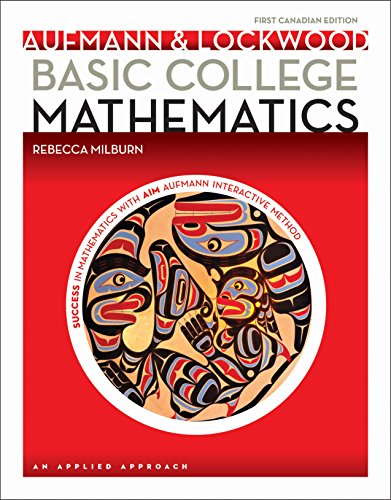Items related to Basic College Mathematics: An Applied Approach

Synopsis
The Student Support Edition of Basic College Mathematics, 8/e, brings comprehensive study skills support to students and the latest technology tools to instructors. In addition, the program now includes concept and vocabulary review material, assignment tracking and time management resources, and practice exercises and online homework to enhance student learning and instruction. With its interactive, objective-based approach, Basic College Mathematics provides comprehensive, mathematically sound coverage of topics essential to the basic college math course. The Eighth Edition features chapter-opening Prep Tests, real-world applications, and a fresh design--all of which engage students and help them succeed in the course. The Aufmann Interactive Method (AIM) is incorporated throughout the text, ensuring that students interact with and master concepts as they are presented.
"synopsis" may belong to another edition of this title.
About the Author
Richard Aufmann is Professor of Mathematics at Palomar College in California. He is the lead author of two best-selling developmental math series, a best-selling college algebra and trigonometry series, as well as several derivative math texts. The Aufmann name is highly recognized and respected among college mathematics faculty.
Vernon Barker has retired from Palomar College where he was Professor of Mathematics. He is a co-author on the majority of Aufmann texts, including the best-selling developmental paperback series.
Joanne Lockwood is co-author with Dick Aufmann and Vernon Barker on the hardback developmental series, Business Mathematics, Algebra with Trigonometry for College Students, and numerous software ancillaries that accompany Aufmann titles. She is also the co-author of Mathematical Excursions with Aufmann.
Review
Note: Each chapter begins with a Prep Test and concludes with a Chapter Summary, Review Exercises, and Test. Chapters 2-6 are followed by Cumulative Review Exercises. 1. Whole Numbers Section 1.1 Introduction to Whole Numbers Section 1.2 Addition of Whole Numbers Section 1.3 Subtraction of Whole Numbers Section 1.4 Multiplication of Whole Numbers Section 1.5 Division of Whole Numbers Section 1.6 Exponential Notation and the Order of Operations Agreement Section 1.7 Prime Numbers and Factoring Focus on Problem Solving: Questions to Ask Projects and Group Activities: Order of Operations, Patterns in Mathematics, Search the World Wide Web 2. Fractions Section 2.1 The Least Common Multiple and Greatest Common Factor Section 2.2 Introduction to Fractions Section 2.3 Writing Equivalent Fractions Section 2.4 Addition of Fractions and Mixed Numbers Section 2.5 Subtraction of Fractions and Mixed Numbers Section 2.6 Multiplication of Fractions and Mixed Numbers Section 2.7 Division of Fractions and Mixed Numbers Section 2.8 Order, Exponents, and the Order of Operations Agreement Focus on Problem Solving: Common Knowledge Projects and Group Activities: Music, Construction, Fractions of Diagrams 3. Decimals Section 3.1 Introduction to Decimals Section 3.2 Addition of Decimals Section 3.3 Subtraction of Decimals Section 3.4 Multiplication of Decimals Section 3.5 Division of Decimals Section 3.6 Comparing and Converting Fractions and Decimals a fraction Focus on Problem Solving: Relevant Information Projects and Group Activities: Fractions as Terminating or Repeating Decimals 4. Ratio and Proportion Section 4.1 Ratio Section 4.2 Rates Section 4.3 Proportions Focus on Problem Solving: Looking for a Pattern Projects and Group Activities: The Golden Ratio, Drawing the Floor Plans for a Building, The U.S. House of Representatives 5. Percents Section 5.1 Introduction to Percents Section 5.2 Percent Equations: Part 1 Section 5.3 Percent Equations: Part II Section 5.4 Percent Equations: Part III Section 5.5 Percent Problems: Proportion Method Focus on Problem Solving: Using a Calculator as a Problem-Solving Tool, Using Estimation as a Problem-Solving Tool Projects and Group Activities: Health, Consumer Price Index 6. Applications for Business and Consumers Section 6.1 Applications to Purchasing Section 6.2 Percent Increase and Percent Decrease Section 6.3 Interest Section 6.4 Real Estate Expenses Section 6.5 Car Expenses Section 6.6 Wages Section 6.7 Bank Statements Focus on Problem Solving: Counterexamples Projects and Group Activities: Buying a Car 7. Statistics and Probability Section 7.1 Pictographs and Circle Graphs Section 7.2 Bar Graphs and Broken-Line Graphs Section 7.3 Histograms and Frequency Polygons Section 7.4 Statistical Measures Section 7.5 Introduction to Probability Focus on Problem Solving: Inductive Reasoning Projects and Group Activities: Deceptive Graphs; Collecting, Organizing, Displaying, and Analyzing Data 8. U.S. Customary Units of Measurement Section 8.1 Length Section 8.2 Weight Section 8.3 Capacity Section 8.4 Time Section 8.5 Energy and Power Focus on Problem Solving: Applying Solutions to Other Problems Projects and Group Activities: Nomographs, Averages 9. The Metric System of Measurement Section 9.1 Length Section 9.2 Mass Section 9.3 Capacity Section 9.4 Energy Section 9.5 Conversion Between the U.S. Customary and the Metric Systems of Measurement Focus on Problem Solving: Working Backward Projects and Group Activities: Name that Metric Unit, Metric Measurements for Computers 10. Rational Numbers Section 10.1 Introduction to Integers Section 10.2 Addition and Subtraction of Integers Section 10.3 Multiplication and Division of Integers Section 10.4 Operations with Rational Numbers Section 10.5 Scientific Notation and the Order of Operations Agreement Focus on Problem Solving: Drawing Diagrams Projects and Group Activities: Deductive Reasoning 11. Introduction to Algebra Section 11.1 Variable Expressions Section 11.2 Introduction to Equations Section 11.3 General Equations: Part I Section 11.4 General Equations: Part II Section 11.5 Translating Verbal Expressions into Mathematical Expressions Section 11.6 Translating Sentences into Equations and Solving Focus on Problem Solving: From Concrete to Abstract Projects and Group Activities: Averages 12. Geometry Section 12.1 Angles, Lines, and Geometric Figures Section 12.2 Plane Geometric Figures Section 12.3 Area Section 12.4 Volume Section 12.5 The Pythagorean Theorem Section 12.6 Similar and Congruent Triangles Focus on Problem Solving: Trial and Error Projects and Group Activities: Investigating Perimeter, Symmetry
"About this title" may belong to another edition of this title.
(No Available Copies)
Search Books: Create a WantCan't find the book you're looking for? We'll keep searching for you. If one of our booksellers adds it to AbeBooks, we'll let you know!
Create a Want
